Téléchargements
Exécutable de l'éditeur de niveaux (Windows 32bits)
Exécutable du jeu (Windows 32bits)
Avant d'essayer de compiler le code, allez dans l'onglet "Projets" dans le menu de gauche, séléctionnez l'onglet "Run" pour votre kit,
et mettez dans "Working directory" le chemin de "editor\data" pour l'éditeur ou "game\data" pour le jeu.
Textes multi-lignes
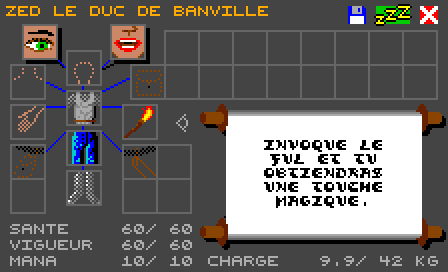

Ces textes sont particuliers. Quand ils sont affichés, ils sont découpés en plusieurs lignes.
Au départ, je pensais que j'utiliserais un paramètre "largeur", et que je découperais le texte quand il serait plus
large que cette largeur en utilisant un algorithme de word-wrapping.
Mais j'ai changé d'avis quand j'ai vu ce texte dans un émulateur:
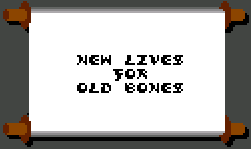
Ici on voit que dans le jeu d'origine ils n'utilisaient pas un algorithme pour limiter la largeur du texte.
S'ils l'avaient fait, la 2ième ligne du texte aurait au moins contenu "FOR OLD" parce que c'est plus court que la
1ère ligne.
Ils ont du insérer des "retours à la ligne" à la main dans le texte de départ.
Alors c'est ce que j'ai fait. J'ai choisi d'utiliser le caractère "_" comme retour à la ligne et voici à quoi
ressemblent les textes des deux parchemins du premier niveau:
<text id="SCROLL00">INVOQUE LE_FUL ET TU_OBTIENDRAS_UNE TOUCHE_MAGIQUE.</text>
<text id="SCROLL01">LES VIEUX OS_AURONT_NOUVELLE VIE</text>
std::vector<std::string> CInterface::getTextLines(std::string text)
{
std::vector<std::string> lines;
size_t start = 0;
size_t end = 0;
while (true)
{
end = text.find('_', start);
if (end != std::string::npos)
{
lines.push_back(text.substr(start, end - start));
start = end + 1;
}
else
{
lines.push_back(text.substr(start, end));
break;
}
}
return lines;
}
Avant d'écrire une fonction pour afficher ce vecteur de strings, je voulais nettoyer un peu la fonction drawText().
Jusqu'à maintenant, elle utilisait une valeur de "8" qui correspondait à la largeur des caractères dans l'image de
la police. J'ai remplacé cette valeur par un define "CHAR_WIDTH".
Elle utilisait aussi une variable bizarre appelée "offset" qui était soustraite de CHAR_WIDTH pour obtenir
l'espacement entre deux caractères à l'écran. J'ai remplacé ça par une fonction.
Alors voila le code "nettoyé":
//------------------------------------------------------------
int CInterface::getCharSpacing(EFonts font)
{
if (font == eFontStandard)
return 6;
else if (font == eFontScroll)
return 6;
else
return 8;
}
//------------------------------------------------------------
#define CHAR_WIDTH 8
void CInterface::drawText(QImage* image, CVec2 pos, EFonts font, const char* text, QColor color)
{
[...]
int spacing = getCharSpacing(font);
[...]
int i = 0;
while (text[i] != 0)
{
int c = codes[text[i] - 32];
CRect rect(CVec2(c * CHAR_WIDTH, 0),
CVec2((c + 1) * CHAR_WIDTH - 1, file.height() - 1));
CVec2 cPos(pos.x + i * spacing, pos.y);
graph2D.drawImageAtlas(image, cPos, file, rect, (font != eFontWalls ? color : QColor(0, 0, 0, 0)));
i++;
}
}
Vous aurez remarqué que chaque ligne de texte est centrée horizontalement.
De plus, pour les parchemins, le texte est centré verticalement dans l'image du parchemin.
Alors notre fonction aura besoin d'un paramètre "height" pour connaitre la hauteur du parchemin. Dans le cas d'un
mur, on mettra ce paramètre à 0.
De plus, on aura besoin d'un paramètre pour la hauteur d'une ligne (la valeur qu'on ajoutera à la coordonnée y
entre chaque ligne sera différente pour les polices des mur et des parchemins).
En dehors de ces paramètres, notre fonction aura les même paramètres que drawText(): position, police, couleur...
Mais comme les lignes sont centrées horizontalement, la coordonnée x de la position nous donnera la position de la
ligne centrale du texte.
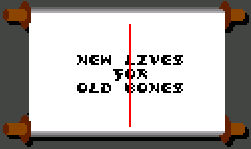
Alors, voici le code de notre fonction:
void CInterface::drawTextMultiLines(QImage* image, CVec2 pos, EFonts font, std::string text, QColor color, int height, int lineHeight)
{
std::vector<std::string> lines = getTextLines(text);
// centre le texte verticalement
if (height != 0)
pos.y += (height - lines.size() * lineHeight) / 2;
// dessine chaque ligne de texte
for (size_t i = 0; i < lines.size(); ++i)
{
CVec2 pos2 = pos;
pos2.x -= lines[i].size() * getCharSpacing(font) / 2;
drawText(image, pos2, font, lines[i].c_str(), color);
pos.y += lineHeight;
}
}
les murs.
Les paramètres des objets
Jusqu'à maintenant le fichier "items.xml" de l'éditeur ne contenait que les noms des objets.
On va maintenant utiliser le même fichier que dans le jeu, et les noms d'objets seront dans un fichier "texts.xml"
(on n'en avait pas encore dans l'éditeur).
Donc ces 2 fichiers fonctionneront exactement comme dans le jeu.
Ensuite, on va devoir ajouter un paramètre "Texte" aux parchemins dans "items.xml".
<!-- PARCHEMIN -->
<item name="ITEM105">
[...]
<param type="string">Texte</param>
</item>
- On a un tableau qui contient les types et les noms des paramètres: mObjectsParams dans CMap
class CMap { [...] std::vector<std::vector<CParamType>> mTilesParams; // liste des paramètres pour chaque type de case std::vector<std::vector<CParamType>> mWallsParams; // liste des paramètres pour chaque type de mur std::vector<std::vector<CParamType>> mObjectsParams; // liste des paramètres pour chaque type d'objet [...] }; - Les valeurs des paramètres sont stockées dans un tableau mParams dans chaque CObject:
class CObject { [...] std::vector<CParam*> mParams; [...] }; - J'ai ajouté quelques fonctions utilitaires pour les manipuler: findParamByName(), getStringParam(),...
- Et bien sur les fonctions existantes de CObject (load(), save(), etc.) ont été modifiées en conséquence.
Paramètres des objets dans l'éditeur
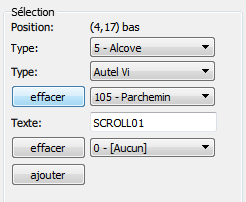
La routine pour créer ces boutons était dupliquée pour les tas d'objets sur le sol et dans les murs. Alors je l'ai
mise dans une nouvelle fonction:
void CEditor::addStackParamsItems(CObjectStack* stack, int startId, QQuickItem* parent, std::vector<QQuickItem *> *list)
{
size_t size = 0;
if (stack != NULL)
{
for (size_t i = 0; i < stack->getSize(); ++i)
{
CObject& obj = stack->getObject(i);
int objType = obj.getType();
addButton(parent, "effacer", list, i);
addComboBox(parent, bridge.itemsList, list, startId + i, objType);
if (objType != 0)
{
std::vector<CParamType>& sourceList = map.mObjectsParams[objType - 1];
for (size_t j = 0; j < sourceList.size(); ++j)
{
CParam* param = obj.mParams[j];
if (sourceList[j].mType == eParamString)
{
CParamString* par = (CParamString*)param;
addLabel(parent, sourceList[j].mName + ":", list);
addTextField(parent, QString::fromStdString(par->mValue), list, (j + 1) * 0x10000 + i);
}
}
}
}
size = stack->getSize();
}
addButton(parent, "ajouter", list, size);
}
On va avoir besoin de retrouver à la fois l'index de l'objet dans le tas et l'index du paramètre dans cet objet.
Alors l'identifiant a cette forme:
<index du paramètre + 1> * 0x10000 + <index de l'objet>
d'un parchemin:
void CBridge::setSelParamText(qint32 id, QString value)
{
[...]
if (mTabIndex == eTabTiles)
{
[...]
}
else if (mTabIndex == eTabWalls)
{
CVec2 pos = editor.mSelectStart / TILE_SIZE;
EWallSide side = editor.getWallSideAbs(editor.mSelectStart);
if (id >= 0x10000)
{
CObjectStack* stack = map.findObjectsStack(pos, side);
int objNum = id & 0xFFFF;
int paramNum = (id / 0x10000) - 1;
CObject& obj = stack->getObject(objNum);
CParamType paramInfos = map.mObjectsParams[obj.getType() - 1][paramNum];
if (paramInfos.mType == eParamString)
{
obj.setStringParam(paramInfos.mName, value.toLocal8Bit().constData());
}
}
else
{
[...]
}
}
else if (mTabIndex == eTabObjects)
{
[même code pour les tas sur le sol]
}
}
Afficher les parchemins
C'est ce qu'on fait dans la fonction drawScroll():
void CInterface::drawScroll(QImage* image, CObject& object)
{
QImage scrollBg = fileCache.getImage("gfx/interface/Scroll.png");
graph2D.drawImage(image, CVec2(80, 85), scrollBg);
if (isPressingEye == true)
{
QImage eye = fileCache.getImage("gfx/interface/Eye.png");
graph2D.drawImage(image, CVec2(83, 90), eye);
}
else
{
QImage arrow = fileCache.getImage("gfx/interface/Arrow.png");
graph2D.drawImage(image, CVec2(83, 90), arrow);
}
std::string text = object.getStringParam("Texte");
drawTextMultiLines(image, CVec2(162, 91), eFontScroll, getText(text), SCROLL_TEXT_COLOR, 59, 7);
}
C'est parce qu'il y a 2 façon de lire un parchemin:
- Soit on le met sur l'oeil dans la feuille du personnage
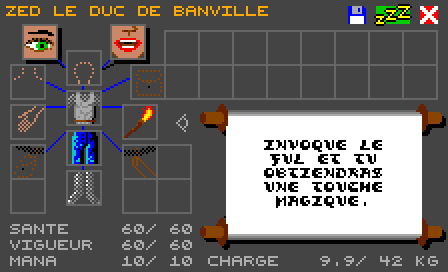
- Ou on le met dans la main droite du personnage
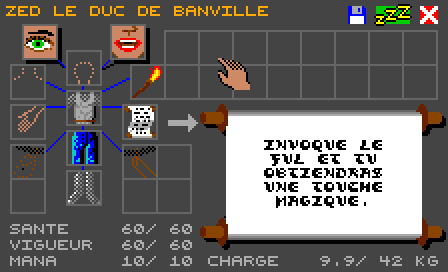
Et dans le 2ième cas, elle est appelée par drawInventory().
Dans ce cas, on doit aussi ajouter un test dans drawBodyPart() pour afficher un parchemin ouvert dans la main:
void CInterface::drawBodyPart(QImage* image, CVec2 pos, int championNum, CCharacter::EBodyParts part, bool enableArea)
{
CCharacter* c = &game.characters[championNum];
int objType = c->bodyObjects[part].getType();
if (objType != 0)
{
// dessine l'objet dans ce slot
CObjects::CObjectInfo object = objects.mObjectInfos[objType - 1];
QImage objImage = fileCache.getImage(object.imageFile.toLocal8Bit().constData());
int imageNum = object.imageNum;
// objets ouverts dans la main
if (part == CCharacter::eBodyPartRightHand)
{
if (objType == OBJECT_TYPE_SCROLL)
imageNum = 30;
}
CRect rect = getItemRect(imageNum);
graph2D.drawImageAtlas(image, pos, objImage, rect);
}
[...]
}
Les textes des murs
<wall name="Texte">
<image>WallText.png</image>
<param type="string">Texte</param>
</wall>
<text id="WALL_TEXT00">HALL DES_CHAMPIONS</text>
<text id="WALL_TEXT01">L'AUTEL_VIM_DE LA_RENAISSANCE</text>
Remarquez qu'on ne l'affiche que quand on est juste en face du mur:
else if (wall->getType() == eWallText)
{
//------------------------------------------------------------------------------
// mur avec texte
std::string text = wall->getStringParam("Texte");
text = interface.getText(text);
if (tablePos == CVec2(2, 3) && side == eWallSideUp)
{
interface.drawTextMultiLines(image, CVec2(112, 74), CInterface::eFontWalls, text, QColor(), 0, 11);
}
}
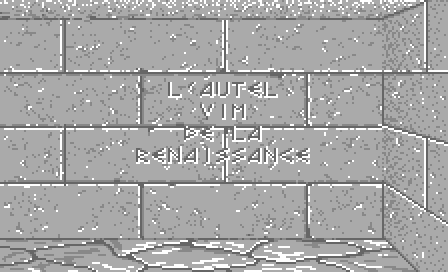
Evidemment, le graphisme du mur est génant pour lire le texte correctement.
Spécialement pour les 2 dernières lignes.
Dans le jeu d'origine il y avait une astuce: Une partie du mur était copiée sur la ligne verticale entre les
briques.
Je n'ai pas trouvé d'image pour ça dans les graphismes d'origine, donc jen ai créé une moi-même (c'est
"TextPatch.png" dans "gfx/3DView").
Une fois qu'on la dessine, voila le résultat:
else if (wall->getType() == eWallText)
{
[...]
if (tablePos == CVec2(2, 3) && side == eWallSideUp)
{
QImage patch = fileCache.getImage("gfx/3DView/TextPatch.png");
graph2D.drawImage(image, CVec2(111, 97), patch);
interface.drawTextMultiLines(image, CVec2(112, 74), CInterface::eFontWalls, text, QColor(), 0, 11);
}
}

La 3ième ligne est encore un peu mal positionnée, alors modifions drawTextMultiLines() pour l'abaisser:
void CInterface::drawTextMultiLines(QImage* image, CVec2 pos, EFonts font, std::string text, QColor color, int height, int lineHeight)
{
[...]
// dessine chaque ligne de texte
for (size_t i = 0; i < lines.size(); ++i)
{
[...]
drawText(image, pos2, font, lines[i].c_str(), color);
pos.y += lineHeight;
if (font == eFontWalls && i == 1)
pos.y += 3;
}
}
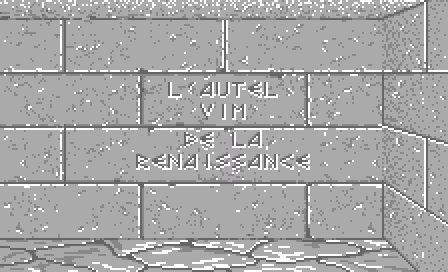
Décor "Texte"
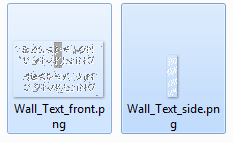
else if (wall->getType() == eWallText)
{
[...]
if (tablePos == CVec2(2, 3) && side == eWallSideUp)
{
[...]
}
else
{
std::vector<std::string> lines = interface.getTextLines(text);
walls.drawOrnate(image, tablePos, side, ORNATE_TEXT, lines.size());
}
}
Dans le jeu d'origine, la taille de ce décor était basée sur le nombre de lignes de texte.
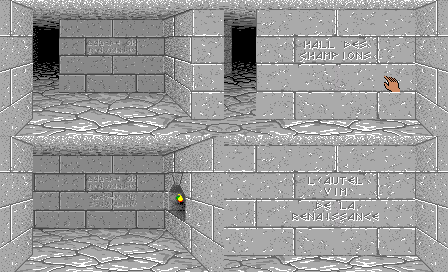
Alors on va devoir modifier drawOrnate pour effectuer ça:
CRect CWalls::drawOrnate(QImage* image, CVec2 tablePos, EWallSide side, int ornate, int textLines)
{
if (ornate != 0)
{
[...]
if (gWallsInfos[tablePos.y][tablePos.x][tableSide].size.x != 0)
{
[...]
// calcule la position et le facteur d'échelle et dessine le décor dans une image temporaire
float scale = (float)ornateTabData->size.y / 111.0f;
QImage ornateImage = fileCache.getImage(ornateFileName.toLocal8Bit().constData());
if (ornate == ORNATE_TEXT)
{
CRect rect;
rect.tl = CVec2(0, 0);
rect.br.x = ornateImage.width() - 1;
if (side == eWallSideUp)
{
static int heights[] = {0, 14, 27, 41, 55};
rect.br.y = heights[textLines];
}
else
{
static int heights[] = {0, 10, 20, 31, 41};
rect.br.y = heights[textLines];
}
ornateImage = graph2D.cropImage(ornateImage, rect);
}
[...]
QImage CGraphics2D::cropImage(const QImage& srcImage, CRect rect)
{
QRect qrect(rect.tl.x, rect.tl.y, rect.br.x - rect.tl.x + 1, rect.br.y - rect.tl.y + 1);
return srcImage.copy(qrect);
}